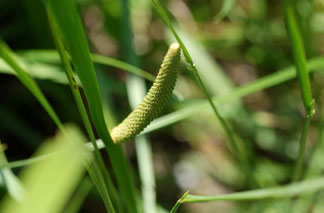EUROPEAN SWEET-FLAG
|
 |
| File Size: 47 KB |
|
|
|
Acorus calamus L.
|
| Neosho County, Kansas |
| Perennial |
| Height: To 5 feet |
| Family: Acoraceae - Sweet-flag Family |
| Flowering Period: May, June, July, August |
|
| Stems: | | Aerial stems absent. Herbage usually aromatic; from branched and creeping rhizomes. | | Leaves: | | Basal, simple, crowded, erect; stipules absent; petioles absent; blade bright green, linear, 35 to 40 inches long, 1/3 to 1 inch wide, sword-shaped, parallel-veined, midvein usually off-center, margins entire. | | Inflorescences: | | Spadix subtended by erect, leaf-like spathe, 8 to 24 inches, which extends beyond spadix; spadix diverging from scape, cylindric, 1.6 to 3.6 inches long, .2 to .4 inch wide, tapered, apex obtuse. | | Flowers: | | Bisexual; radially symmetric; tepals 6, distinct; stamens 6, distinct; style 1; stigma 1. | | Fruits: | | Fruits are not produced. | | Habitat: | | Marshes, swamps, and backwater areas along rivers | | Distribution: | | Scattered in east 3/4 of Kansas | | Origin: | | Introduced | | Uses: | | Introduced to North American for its medicinal uses. Native Americans used sweet-flag as a medicine and for ceremonial uses. It provides habitat for waterfowl. | | Comments: | | This species is a sterile triploid.
Acorus historically has been placed in the Araceae. The name Acorus calamus long has been applied to North American plants, but evidence supports recognition of two species: the European A. calamus and the native A. americanus (Raf.) Raf. Acorus americanus occurs in eastern Nebraska but has not been found in Kansas. |
|
| European sweet-flag leaves |  | | 166 KB | | Neosho County, Kansas |
| | European sweet-flag |  | | 125 KB | | Neosho County, Kansas |
| | European sweet-flag spadix |  | | 58 KB | | Neosho County, Kansas |
| | |
|
|
|
|
|
|